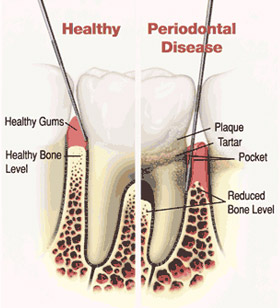The gums and jaw bone form the foundation to hold our teeth in place. We need our teeth not only to maintain a healthy diet as well as to look socially acceptable; both of which are important to our physical and emotional well-being.
A common myth is that we will lose our teeth as we age and hence, check ups and regular cleanings are not important. This cannot be further away from the truth.
Decay (caries) and gum (periodontal) disease are the most common reasons people lose teeth and both can be prevented in most cases.
What is Periodontal Disease?
Periodontal (gum) disease is a chronic bacterial infection that affects the gums and bone supporting the teeth. Periodontal diseases consists of gingivitis and periodontitis.
Periodontal disease can affect one tooth or many teeth. It begins when the bacteria in plaque (the sticky, colorless film that constantly forms on your teeth) causes the gums to become red or inflamed. Any plaque that has not been removed by the toothbrush or floss will harden to become tartar after a short period of time. Tartar can only be removed via scaling by a dentist. Plaque and tartar also occurs up to 3mm beneath the gum line as there is a natural space or pocket of 3mm in depth surrounding each tooth. Please see diagram below for gum pocket.
Gingivitis
During this stage, the gums redden, swell and bleed easily. There is usually little or no discomfort. This condition is called gingivitis and a recent survey done in Singapore indicates that more than 80% of the population show some signs of it. It is usually caused by poor oral hygiene practices and techniques. Most people ignore the problem of bleeding gums on brushing as there is no pain. Over time, if left untreated, gingivitis can progress to periodontitis.
Periodontitis

With time, plaque can spread and grow below the gum line. Toxins or poisons produced by the bacteria in plaque invade the gums and eventually causes the bone that support the teeth to be destroyed. Gums separate from the teeth, forming pockets (spaces between the teeth and gums) that may become infected. As the disease progresses, the pockets deepen and more gum tissue and bone are destroyed. Often, this destructive process has no or very mild symptoms. Eventually, teeth can become loose, move out of position or pus and swellings may develop. It is often at this late stage that the patient realizes something is wrong and seeks treatment. However, treatment may not be always successful at this stage.
The gum pocket is located between the gums and tooth and highlighted by the slim pointer entering the gums in the diagram.
Common signs of periodontal disease
- 1. Bleeding on brushing
- 2. Loose teeth
- 3. Separated teeth or teeth that have moved from their original positions
- 4. Pus or swellings
- 5. Bad breath
What can be done to prevent Periodontal disease?
Most of the time, periodontal disease occurs due to neglect or ignorance. To prevent gingivitis and periodontitis, the following should be done:
- 1. Visit the dentist/Periodontist for a gum check. This check takes at least 10 min and you may experience some discomfort. It may be painful in patients who already have gum disease. X rays are often taken to confirm bone levels
- 2. Follow the dentist’s recommendation to seek periodontal treatment if needed. If no specialist treatment is needed, visit your dentist regularly for a thorough scaling and polishing. If tartar is allowed to accumulate, periodontitis will occur sometime in life. Scalings are not painless but readily tolerated by the patient. Absolutely painless or quick scalings does not always mean that the dentist is skillful as tartar can occur beneath the gum line and 360 degrees around each tooth
- 3. Use a soft or extra soft toothbrush and follow the dentist’s recommendation of an efficient method of brushing and flossing. Floss once a day or use other interdental aids if unable to floss
